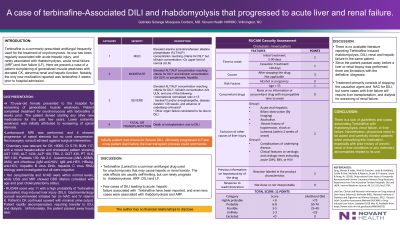Tuesday Poster Session
Category: Liver
P3871 - A Case of Terbinafine-Associated DILI and Rhabdomyolysis That Progressed to Liver and Acute Renal Failure
Tuesday, October 24, 2023
10:30 AM - 4:00 PM PT
Location: Exhibit Hall

Has Audio

Gabriela S. Mosquera Cordero, MD
Novant Health NHRMC
Wilmington, NC
Presenting Author(s)
Gabriela S. Mosquera Cordero, MD
Novant Health NHRMC, Wilmington, NC
Introduction: Terbinafine is usually prescribed for the treatment of onychomycosis. Its use has been commonly associated with acute hepatic injury and rarely associated with rhabdomyolysis, acute renal failure (ARF) and liver failure (LF). Here we present a case of a patient complaining of general muscle weakness with elevated CK, abnormal renal and hepatic function. Notably, the only new medication reported was terbinafine 3 weeks prior to hospital admission.
Case Description/Methods: A 72 year-old female presented to the hospital for worsening of general muscle weakness. Patient completed
treatment for onychomycosis with terbinafine 3 weeks prior. The patient denied starting any other new medications for the past few years. Lower extremity weakness was initially associated with worsening of spinal stenosis. Spine MRI was performed and it showed progression of spinal stenosis but no cord compression. Chemistry was relevant for CK >9000; Cr 5.78; BUN 117; with a mixed hepatocellular and cholestatic pattern showing AST 1395; ALT 1434; ALP 180; TBIL 2, GGT 339, PT 18.6; INR 1.80, Platelets 139, Albumin 2.4. Autoimmune, infectious etiology were investigated but all were negative. Her ceruplasmide and A1AD were within normal levels, while USG and MRI showed CBD dilation correlated with age and post cholecystectomy status. RUCAM score was 11 with a high probability of Terbinafine associated drug induced liver injury (DILI). Gastroenterology initiated her on NAC and IV vitamin K. Patient’s CK continued trending up with minimal urine output. Patient rapidly decompensated, requiring transfer to ICU, started dialysis but unfortunately the patient passed away hours later.
Discussion: Terbinafine is a common antifungal drug used for onychomycosis that may cause hepatic or renal toxicity with a very low incidence. The side effects are usually self limiting, but can rarely present as rhabdomyolysis, ARF, DILI and LF. Few cases of DILI leading to acute hepatic failure associated with Terbinafine have been reported, and even less cases were associated with rhabdomyolysis and ARF. There is no available literature reporting Terbinafine induced rhabdomyolysis, renal and hepatic failure in the same patient. Since the patient passed away before a liver or renal biopsy was performed, there are limitations with the diagnosis. Treatment primarily consists of stopping the causing agent and NAC for DILI, but some cases with liver failure will require liver transplantation, and dialysis for worsening of renal failure.
Disclosures:
Gabriela S. Mosquera Cordero, MD. P3871 - A Case of Terbinafine-Associated DILI and Rhabdomyolysis That Progressed to Liver and Acute Renal Failure, ACG 2023 Annual Scientific Meeting Abstracts. Vancouver, BC, Canada: American College of Gastroenterology.
Novant Health NHRMC, Wilmington, NC
Introduction: Terbinafine is usually prescribed for the treatment of onychomycosis. Its use has been commonly associated with acute hepatic injury and rarely associated with rhabdomyolysis, acute renal failure (ARF) and liver failure (LF). Here we present a case of a patient complaining of general muscle weakness with elevated CK, abnormal renal and hepatic function. Notably, the only new medication reported was terbinafine 3 weeks prior to hospital admission.
Case Description/Methods: A 72 year-old female presented to the hospital for worsening of general muscle weakness. Patient completed
treatment for onychomycosis with terbinafine 3 weeks prior. The patient denied starting any other new medications for the past few years. Lower extremity weakness was initially associated with worsening of spinal stenosis. Spine MRI was performed and it showed progression of spinal stenosis but no cord compression. Chemistry was relevant for CK >9000; Cr 5.78; BUN 117; with a mixed hepatocellular and cholestatic pattern showing AST 1395; ALT 1434; ALP 180; TBIL 2, GGT 339, PT 18.6; INR 1.80, Platelets 139, Albumin 2.4. Autoimmune, infectious etiology were investigated but all were negative. Her ceruplasmide and A1AD were within normal levels, while USG and MRI showed CBD dilation correlated with age and post cholecystectomy status. RUCAM score was 11 with a high probability of Terbinafine associated drug induced liver injury (DILI). Gastroenterology initiated her on NAC and IV vitamin K. Patient’s CK continued trending up with minimal urine output. Patient rapidly decompensated, requiring transfer to ICU, started dialysis but unfortunately the patient passed away hours later.
Discussion: Terbinafine is a common antifungal drug used for onychomycosis that may cause hepatic or renal toxicity with a very low incidence. The side effects are usually self limiting, but can rarely present as rhabdomyolysis, ARF, DILI and LF. Few cases of DILI leading to acute hepatic failure associated with Terbinafine have been reported, and even less cases were associated with rhabdomyolysis and ARF. There is no available literature reporting Terbinafine induced rhabdomyolysis, renal and hepatic failure in the same patient. Since the patient passed away before a liver or renal biopsy was performed, there are limitations with the diagnosis. Treatment primarily consists of stopping the causing agent and NAC for DILI, but some cases with liver failure will require liver transplantation, and dialysis for worsening of renal failure.
Disclosures:
Gabriela Mosquera Cordero indicated no relevant financial relationships.
Gabriela S. Mosquera Cordero, MD. P3871 - A Case of Terbinafine-Associated DILI and Rhabdomyolysis That Progressed to Liver and Acute Renal Failure, ACG 2023 Annual Scientific Meeting Abstracts. Vancouver, BC, Canada: American College of Gastroenterology.
